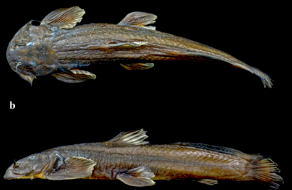New Catfish Species Exostoma Sentiyonoae Discovered in Nagaland
A new species of catfish, called Exostoma sentiyonoae, has been discovered in the Dzuleke River in Nagaland, India. This river is part of the Barak River system, and the discovery is important because it shows how rich the region’s aquatic life is.
Publication Details
The discovery was published in the scientific journal Zootaxa by two researchers:
- Bungdon Shangningam from the Zoological Survey of India.
- Limatemjen from Kohima Science College.
The newly found fish is cataloged as holotype ZSI FF 9871 and measures 75.8 mm in length.
Characteristics of Exostoma sentiyonoae
This new catfish has unique features that make it different from other fish in the same genus. Some of its special characteristics include:
- Adipose fin (a small fin on the back) connected to its upper caudal-fin rays.
- Tubercles (small bumps) on its dorsal fin spine.
- A slender head.
- A large distance between the dorsal fin and adipose fin.
- Small eyes and a total of 41 vertebrae.
Taxonomic Distinctions
The researchers found differences between Exostoma sentiyonoae and similar species, such as:
- Compared to E. berdmorei, it has a shorter dorsal-fin base, longer distance between dorsal and adipose fins, and smaller eyes.
- Compared to E. gaoligongense, it has a shorter distance between pectoral and pelvic fins, and smaller eyes.
- From species like E. effreni (in the Chao Phraya River), it differs by having a wider head and a deeper caudal peduncle (tail area).
- From E. peregrinator, it has a longer dorsal-adipose fin distance and a shorter anal-fin base.
This is the first time a member of the Exostoma genus has been found in the Dzuleke River. The discovery shows that there could be many more undiscovered species in the area because of its rough terrain and limited research on fish.
Future Research Directions
The researchers stress the need for more studies on Nagaland’s rivers. They suggest:
- Doing more surveys to explore other possible fish species, including genetic studies.
- Investigating how these species are distributed and how they interact with their environment.
- Developing conservation plans to protect the unique species and biodiversity in the region.
The discovery of Exostoma sentiyonoae is an exciting step in understanding the diversity of fish in Nagaland. It also contributes to the larger conservation efforts in important biodiversity regions like the Eastern Himalayas and Indo-Burma. More research is needed to uncover other fish species in these remote areas.
Month: Current Affairs - September, 2024
Category: Science & Technology Current Affairs


